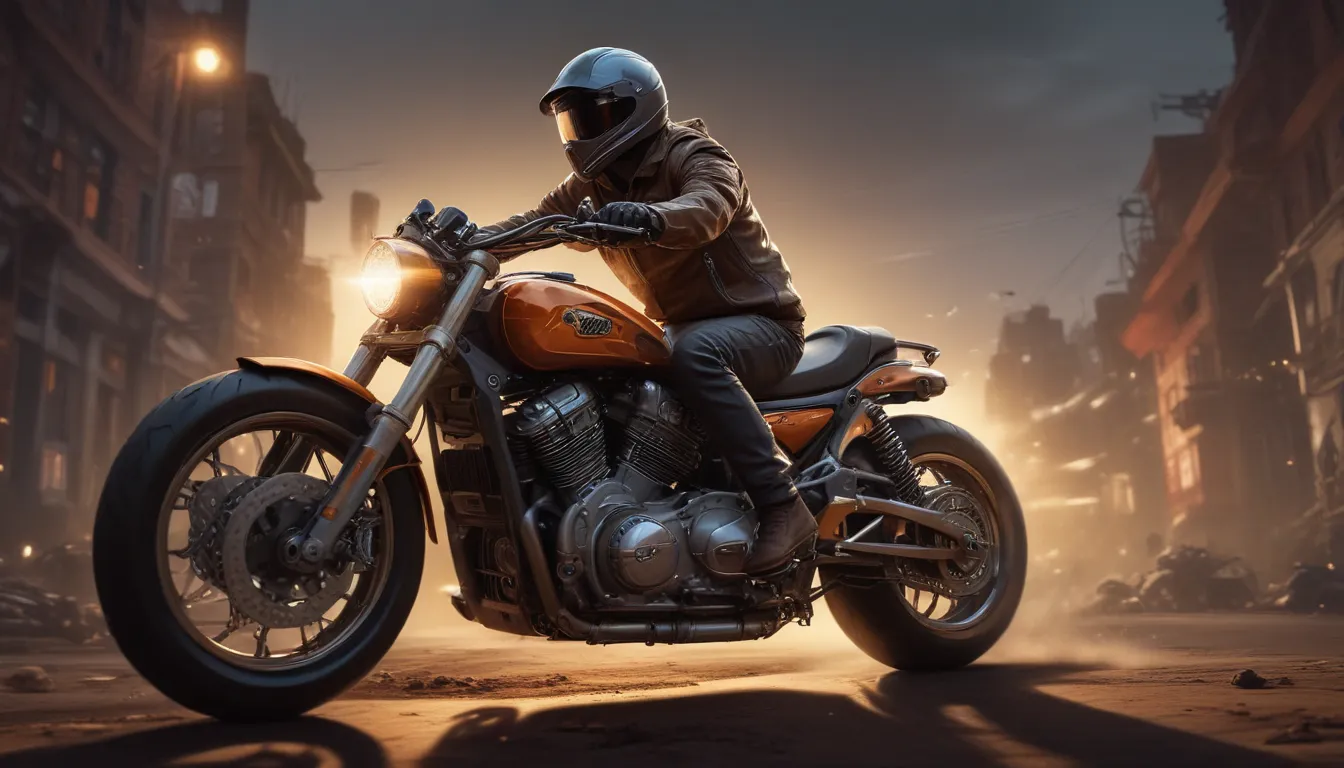A Note About Images: The images used in our articles are for illustration purposes only and may not exactly match the content. They are meant to engage readers, but the text should be relied upon for accurate information.
Motorcycles have always held a special allure, captivating individuals with their sleek design, raw power, and a sense of freedom that beckons riders to hit the open road. These two-wheeled marvels have a rich history, boasting technological advancements and a cultural significance that continues to attract enthusiasts worldwide. In this article, we will delve into 11 fascinating facts about motorcycles, shedding light on their origins, evolution, and impact on society. Whether you’re a seasoned rider or simply intrigued by these machines, get ready to embark on an exhilarating journey through the world of motorcycles.
Tracing the Roots of Motorcycles
The motorcycle, in its modern form, traces its origins back to the late 19th century. In 1885, German inventors Gottlieb Daimler and Wilhelm Maybach unveiled the world’s first gasoline-powered motorcycle, known as the “Reitwagen.” Featuring a wooden frame, a single-cylinder engine, and a top speed of approximately 11 miles per hour, the Reitwagen laid the foundation for future motorcycle designs and paved the way for the thriving modern motorcycle industry.
Unleashing Speed: The Fastest Production Motorcycle
Speed is a defining characteristic of motorcycles, and some models have pushed the boundaries of velocity. The title of the fastest production motorcycle currently belongs to the Dodge Tomahawk, introduced in 2003. Powered by a 10-cylinder, 8.3-liter engine borrowed from the Dodge Viper sports car, this extraordinary machine boasts a top speed of around 350 miles per hour, showcasing the incredible engineering prowess of motorcycle manufacturers.
The Art of Motorcycle Stunt Riding
Stunt riding adds a thrilling and adrenaline-pumping dimension to the world of motorcycles, captivating audiences worldwide. Riders perform jaw-dropping tricks and maneuvers, from wheelies and stoppies to daring jumps and acrobatic feats, showcasing exceptional skill, balance, and control. Stunt riding, popularized by legendary figures like Evel Knievel and Robbie Maddison, has become a prominent form of entertainment, pushing the limits of what motorcycles can achieve.
Embracing Enormity: The World’s Largest Motorcycle
While motorcycles come in various shapes and sizes, one particular creation stands out for its sheer enormity. The world’s largest motorcycle, named “Reggie,” was crafted by Gregory Dunham in the United States. This colossal machine measures a staggering 16.16 feet in height, 32.61 feet in length, and weighs over 6,500 pounds. Reggie is not only a marvel of engineering but also a testament to the boundless imagination and passion of motorcycle enthusiasts worldwide.
Timeless Legacy: The History of Harley-Davidson
Harley-Davidson stands as a legendary name in the motorcycle industry, boasting a storied history that spans over a century. Founded in 1903 in Milwaukee, Wisconsin, by William S. Harley and Arthur Davidson, the company has become an iconic symbol of American motorcycle manufacturing. Renowned for their distinctive V-twin engines and timeless designs, Harley-Davidson motorcycles have garnered a loyal following and played a significant role in shaping motorcycle culture.
Engine Evolution: Advancements in Motorcycle Technology
Motorcycles have witnessed remarkable advancements in engine technology throughout their history. From simple single-cylinder engines to sophisticated multi-cylinder powerhouses, the evolution of motorcycle engines showcases human ingenuity at its finest. Various engine configurations, including inline, V-twin, and flat-twin setups, offer a unique blend of power, efficiency, and character, contributing to the thrilling performance and distinctive sound of motorcycles.
Enhancing Safety: The First Motorcycle Helmet
Safety remains paramount when riding motorcycles, with the invention of the motorcycle helmet playing a pivotal role in protecting riders from head injuries. In 1953, Professor C.F. “Red” Lombard introduced the first motorcycle helmet, the “Lombard Crash Helmet,” featuring a hard fiberglass shell and a padded interior for enhanced comfort. Subsequent advancements in helmet design have incorporated state-of-the-art materials and features to provide maximum protection for riders.
War Machines: The Role of Motorcycles in World War II
Motorcycles have played a crucial role in warfare, particularly during World War II. Armies utilized motorcycles for reconnaissance, communication, and transportation, with the German military leveraging models like the BMW R75 for their versatility and reliability on the battlefield. These two-wheeled vehicles proved invaluable for maneuvering through challenging terrain, delivering messages swiftly, and offering essential support to infantry units during wartime.
Speed and Spectacle: The World of Motorcycle Racing
Motorcycle racing has captivated audiences since its inception, showcasing the skills of riders and the performance capabilities of their machines. From high-speed road races to exhilarating motocross events, iconic races like the Isle of Man TT, MotoGP, and the Dakar Rally have become legendary fixtures in the racing world. Motorcycle racing pushes the boundaries of speed, endurance, and technology, driving advancements in motorcycle engineering and captivating enthusiasts globally.
Personal Expression: Customizing Motorcycles
Custom motorcycles represent a unique form of self-expression and craftsmanship within the motorcycle community. Riders and builders modify and personalize their bikes to reflect their individual styles and preferences, creating custom choppers, bobbers, cafe racers, and street trackers that showcase creativity and attention to detail. These one-of-a-kind machines embody the spirit of individualism and have become an integral part of motorcycle culture worldwide.
Embracing Innovation: The Rise of Electric Motorcycles
In recent years, the motorcycle industry has witnessed a significant shift towards electric motorcycles due to growing environmental concerns and the quest for efficient transportation solutions. Electric motorcycles offer instant torque, quiet operation, and reduced emissions, appealing to eco-conscious riders seeking a sustainable alternative to traditional combustion-powered bikes. Advancements in battery technology are driving the popularity and viability of electric motorcycles in today’s market.
Concluding Thoughts on the World of Motorcycles
In conclusion, motorcycles embody a rich and engrossing history that continues to evolve alongside technological advancements and changing societal preferences. From their modest beginnings to the cutting-edge machines of today, motorcycles have captivated individuals worldwide with their allure. Whether you revel in the thrill of high-speed racing, appreciate the artistry of custom builds, or savor the freedom of cruising on two wheels, motorcycles offer an unparalleled experience that transcends mere transportation. So, set out on your bike, embrace the open road, and revel in the joy of motorcycle exploration.
Answering Common Inquiries About Motorcycles
Are motorcycles dangerous?
Motorcycles can pose risks if not operated with caution and appropriate safety measures in place. Protective gear such as helmets, jackets, gloves, and boots are essential for riders. Enrolling in motorcycle safety courses and adhering to traffic laws can help mitigate risks and ensure a safer riding experience.
What is the average lifespan of a motorcycle?
The lifespan of a motorcycle varies based on factors like maintenance, usage, and the specific model. With regular care and maintenance, motorcycles can last for decades. Individual components, such as engines or tires, may require periodic replacement to keep the bike running smoothly.
How fuel-efficient are motorcycles?
Fuel efficiency in motorcycles depends on variables like engine size, riding conditions, and riding habits. Generally, motorcycles offer better fuel efficiency than cars, with smaller displacement models often achieving higher mileage. However, aggressive riding styles can impact fuel efficiency negatively.
What is the best motorcycle for beginners?
For beginners, starting with smaller, more manageable motorcycles featuring lower engine displacements is recommended. Models like the Honda CB300R, Yamaha YZF-R3, or Kawasaki Ninja 400 are popular choices for novice riders due to their user-friendly features, manageable power, and comfortable ergonomics.
Can motorcycles be used for long-distance travel?
Yes, motorcycles can be used for long-distance journeys. Touring motorcycles are specifically designed for comfortable and efficient extended rides, featuring larger fuel tanks, wind protection, comfortable seating, and luggage options to accommodate long trips. Popular touring models include the BMW R1250GS, Honda Gold Wing, and Harley-Davidson Electra Glide.
As you explore the fascinating realm of motorcycles, our dedication to providing reliable and engaging content remains unwavering. Each fact shared on our site is sourced from real users like you, ensuring a diverse array of insights and information. Our meticulous editors diligently review each submission to guarantee the highest standards of accuracy and credibility. Trust in our commitment to quality and authenticity as you delve into the world of motorcycles and expand your knowledge with us.






